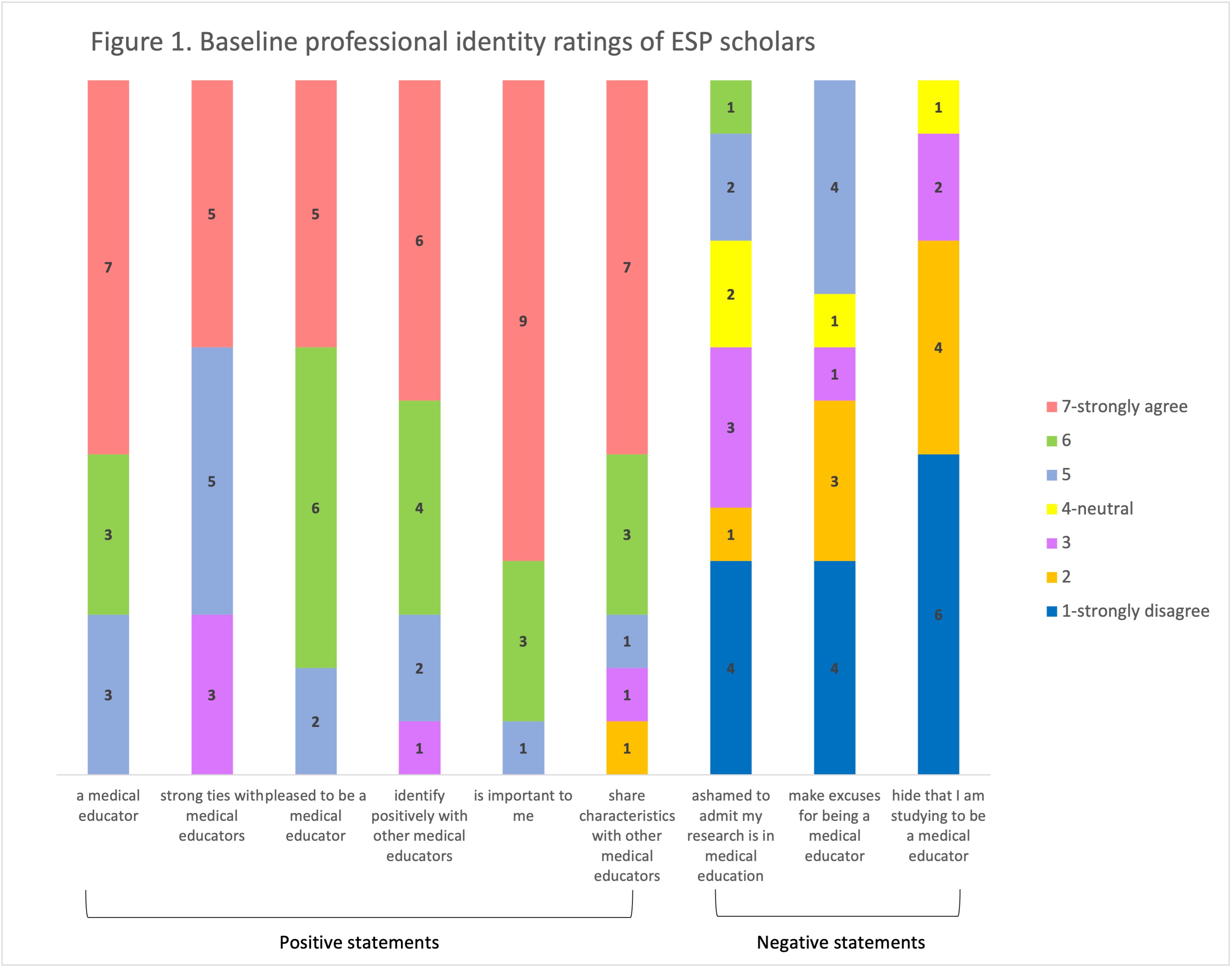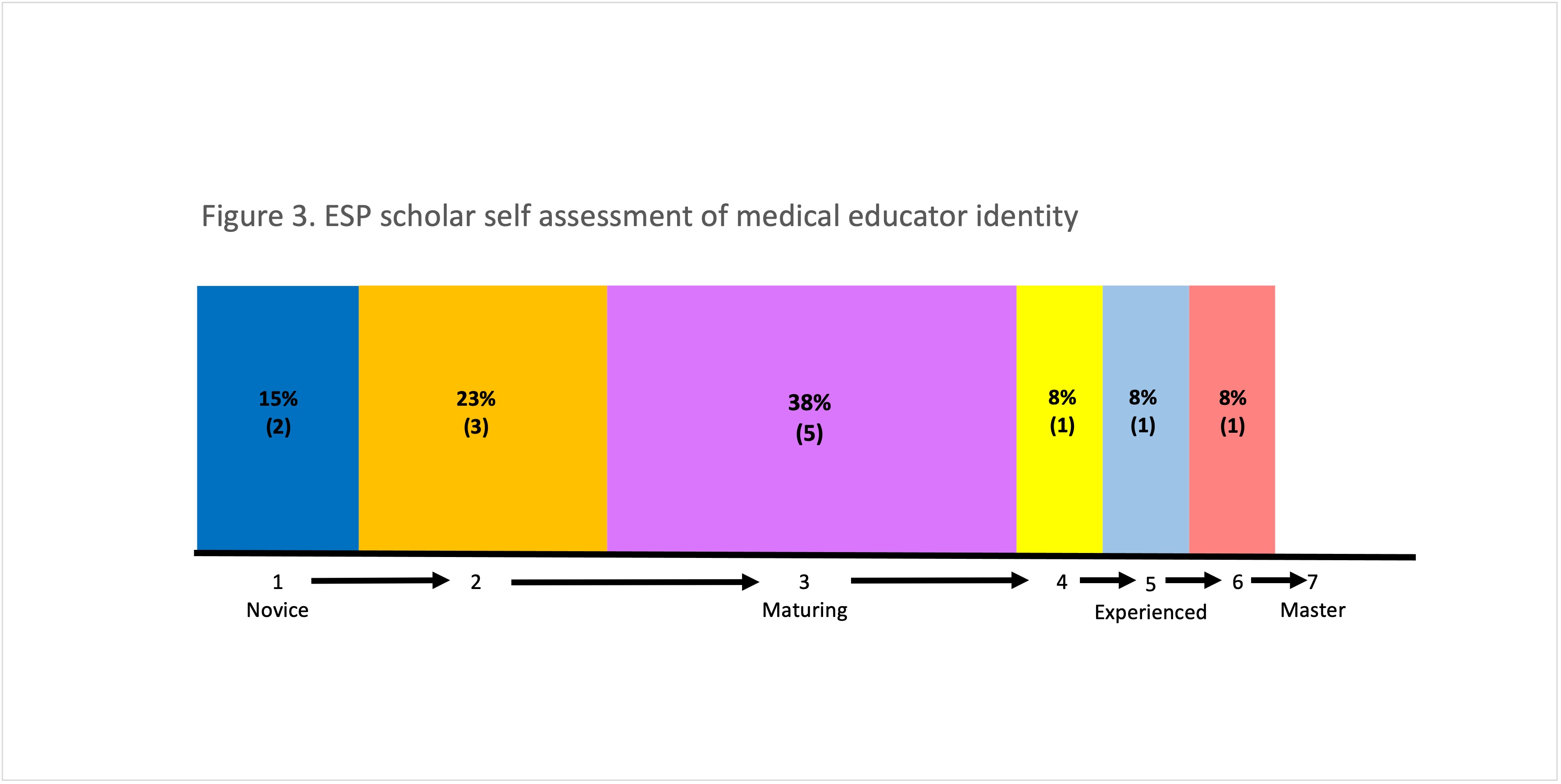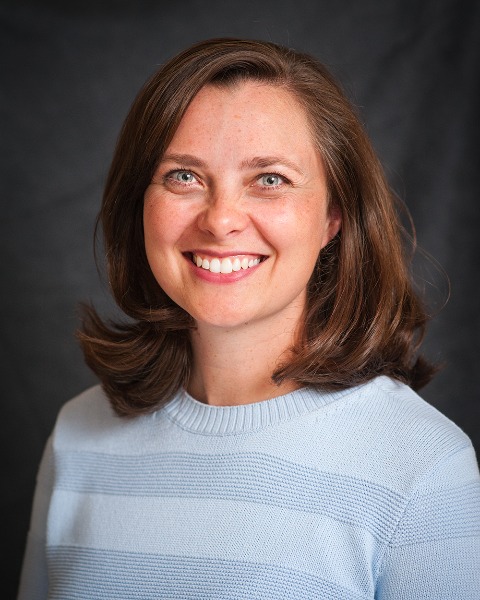Back
Background: Believing one is a member of a professional field is important for career satisfaction, but little research focuses on the professional identity formation (PIF) of medical educators or how faculty development programs (FDP) support their PIF. The Academic Pediatric Association Educational Scholars Program (ESP) is a 3-year FDP in educational scholarship that builds a community of practice, catalyzing participants from clinical educators to educational scholars.
Objective: To evaluate the ESP’s impact on medical educators’ PIF through describing changes in self-reported PIF and exploration of factors leading to identification as an educator. We hypothesize that ESP participation leads to growth in educator identity over time. Baseline PIF characteristics of current scholars are reported here.
Design/Methods: 28 current ESP scholars were invited to participate in this prospective study. Surveys using a modified Macleod-Clark Professional Identity Scale (MCPIS-9) and self-assessment of current identity as a medical educator were distributed. Baseline data was collected in Spring 2022 at the start of ESP participation. Descriptive statistical analysis was performed.
Results: 13/28 faculty completed the survey (46%). On the MCPIS-9, a majority endorse agreement with positive statements related to medical educator identity. More variation was noted in negative identity statements, with a minority endorsing hiding their development as a medical educator. A majority self-identify as educators early in a continuum of development: 2/13 (15%) as novice, 3/13 (23%) as novice-maturing, and 5/13 (38%) as maturing. Qualitative exploration of factors influencing educator identification reveals themes of scholarly productivity (number of publications, need for research skills), external recognition (awards, leadership roles) and mentorship (need for mentorship, ability to mentor others). Professional connections were also considered important, in particular for ESP and local networks.
Conclusion(s): Faculty enter ESP with different levels of identification as medical educators. While the majority endorse agreement with positive attributes of medical educator identity, a minority make excuses or feel ashamed. Our planned 5-year longitudinal assessment of PIF with this faculty cohort should expand on this baseline analysis describing the impact of a longitudinal FDP has on educator PIF and the impact the ESP community of practice has on these positive and negative associations.

.jpg)

Medical Education: Faculty Development
Medical Education 5: Faculty Development 1
514 - Becoming an Educator: Professional Identity Formation in a Medical Educator Faculty Development Program
Saturday, April 29, 2023
3:30 PM – 6:00 PM ET
Poster Number: 514
Publication Number: 514.227
Publication Number: 514.227
Jessica Goldstein, University of Minnesota Masonic Children's Hospital, Minneapolis, MN, United States; Julia Aquino, Boston Children's Hospital, Winchester, MA, United States; Hollyce Tyrrell, Academic Pediatric Association, McLean, VA, United States; Donna M.. D'Alessandro, University of Iowa, Iowa city, IA, United States

Jessica Goldstein, MD (she/her/hers)
Associate Professor
University of Minnesota Masonic Children's Hospital
Minneapolis, Minnesota, United States
Presenting Author(s)
Background: Believing one is a member of a professional field is important for career satisfaction, but little research focuses on the professional identity formation (PIF) of medical educators or how faculty development programs (FDP) support their PIF. The Academic Pediatric Association Educational Scholars Program (ESP) is a 3-year FDP in educational scholarship that builds a community of practice, catalyzing participants from clinical educators to educational scholars.
Objective: To evaluate the ESP’s impact on medical educators’ PIF through describing changes in self-reported PIF and exploration of factors leading to identification as an educator. We hypothesize that ESP participation leads to growth in educator identity over time. Baseline PIF characteristics of current scholars are reported here.
Design/Methods: 28 current ESP scholars were invited to participate in this prospective study. Surveys using a modified Macleod-Clark Professional Identity Scale (MCPIS-9) and self-assessment of current identity as a medical educator were distributed. Baseline data was collected in Spring 2022 at the start of ESP participation. Descriptive statistical analysis was performed.
Results: 13/28 faculty completed the survey (46%). On the MCPIS-9, a majority endorse agreement with positive statements related to medical educator identity. More variation was noted in negative identity statements, with a minority endorsing hiding their development as a medical educator. A majority self-identify as educators early in a continuum of development: 2/13 (15%) as novice, 3/13 (23%) as novice-maturing, and 5/13 (38%) as maturing. Qualitative exploration of factors influencing educator identification reveals themes of scholarly productivity (number of publications, need for research skills), external recognition (awards, leadership roles) and mentorship (need for mentorship, ability to mentor others). Professional connections were also considered important, in particular for ESP and local networks.
Conclusion(s): Faculty enter ESP with different levels of identification as medical educators. While the majority endorse agreement with positive attributes of medical educator identity, a minority make excuses or feel ashamed. Our planned 5-year longitudinal assessment of PIF with this faculty cohort should expand on this baseline analysis describing the impact of a longitudinal FDP has on educator PIF and the impact the ESP community of practice has on these positive and negative associations.

.jpg)

